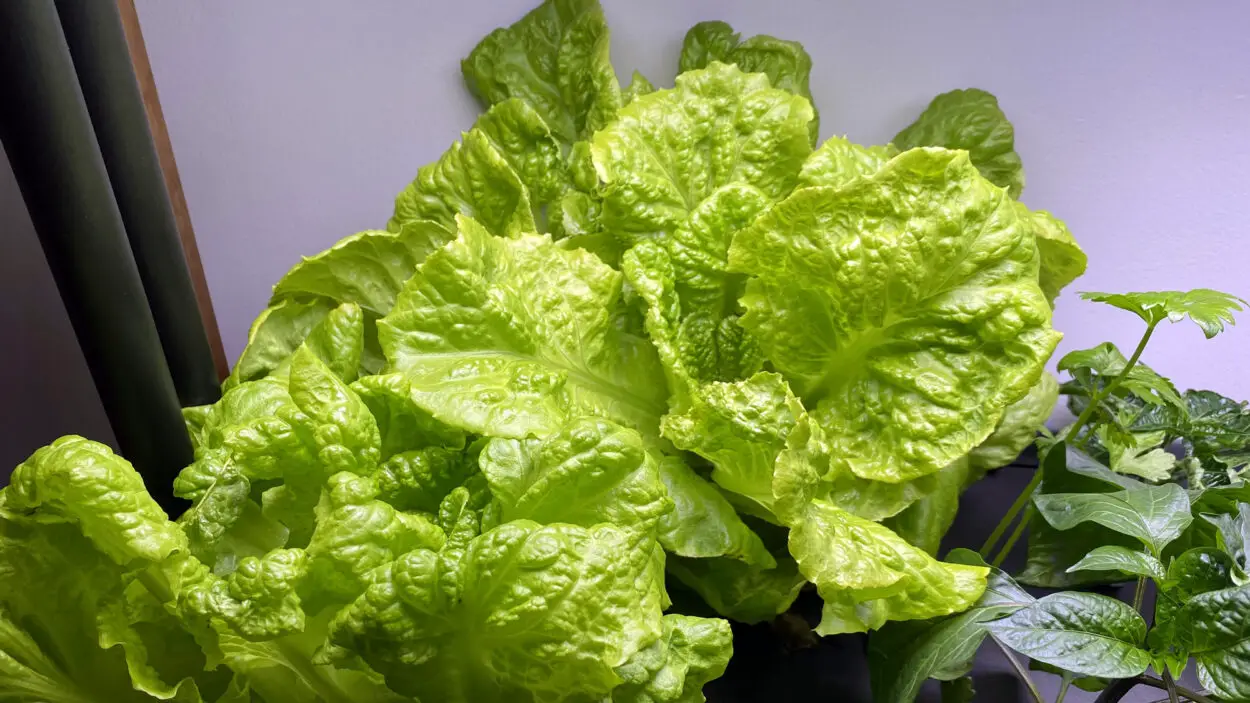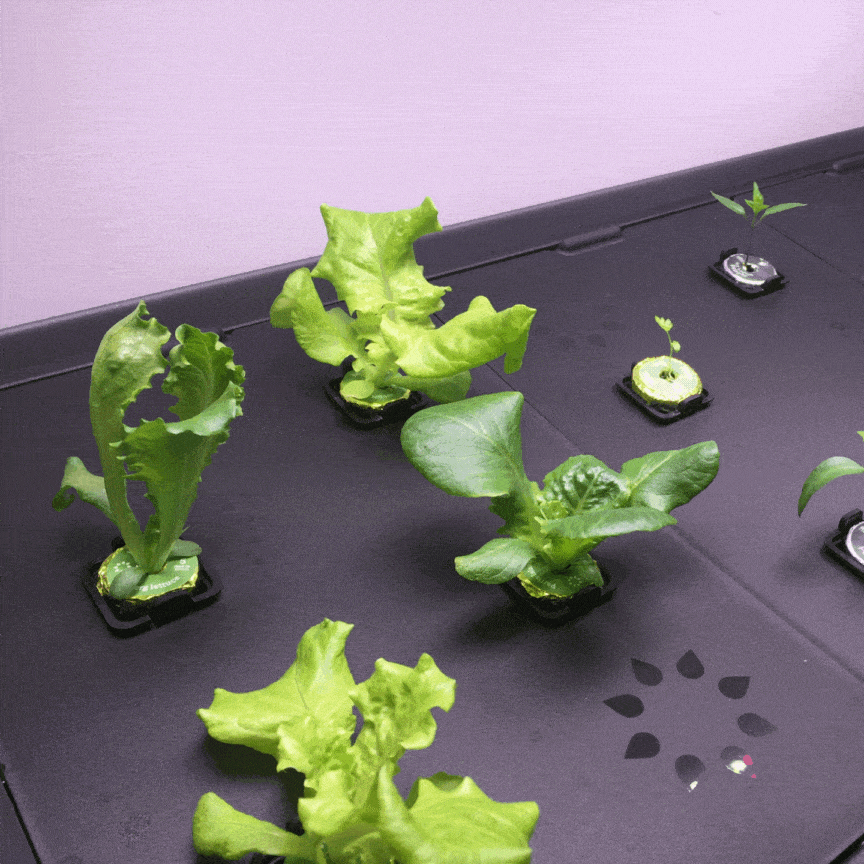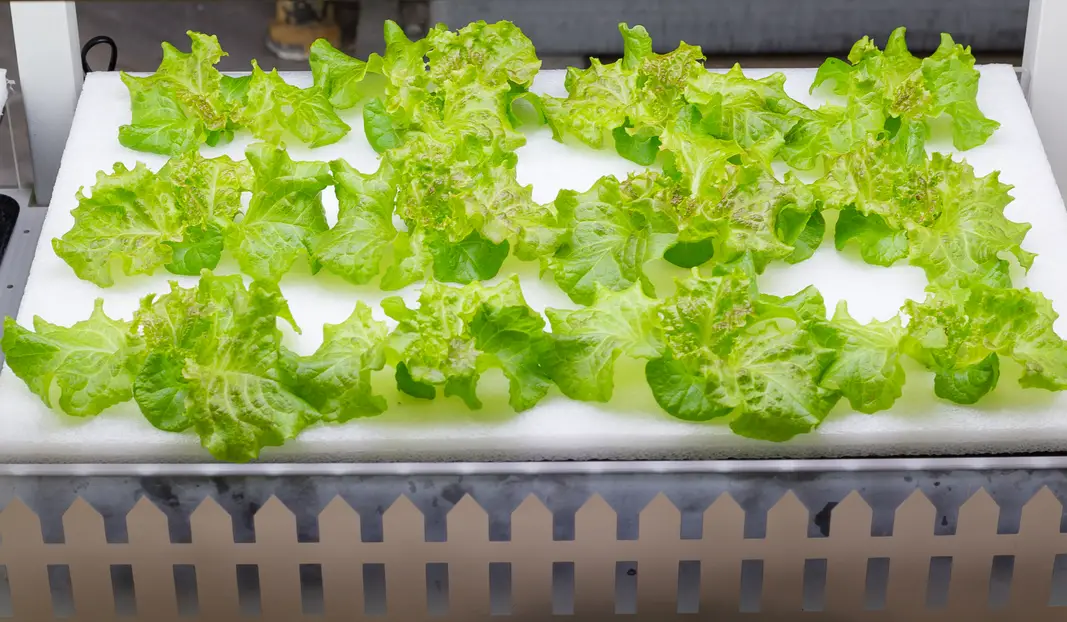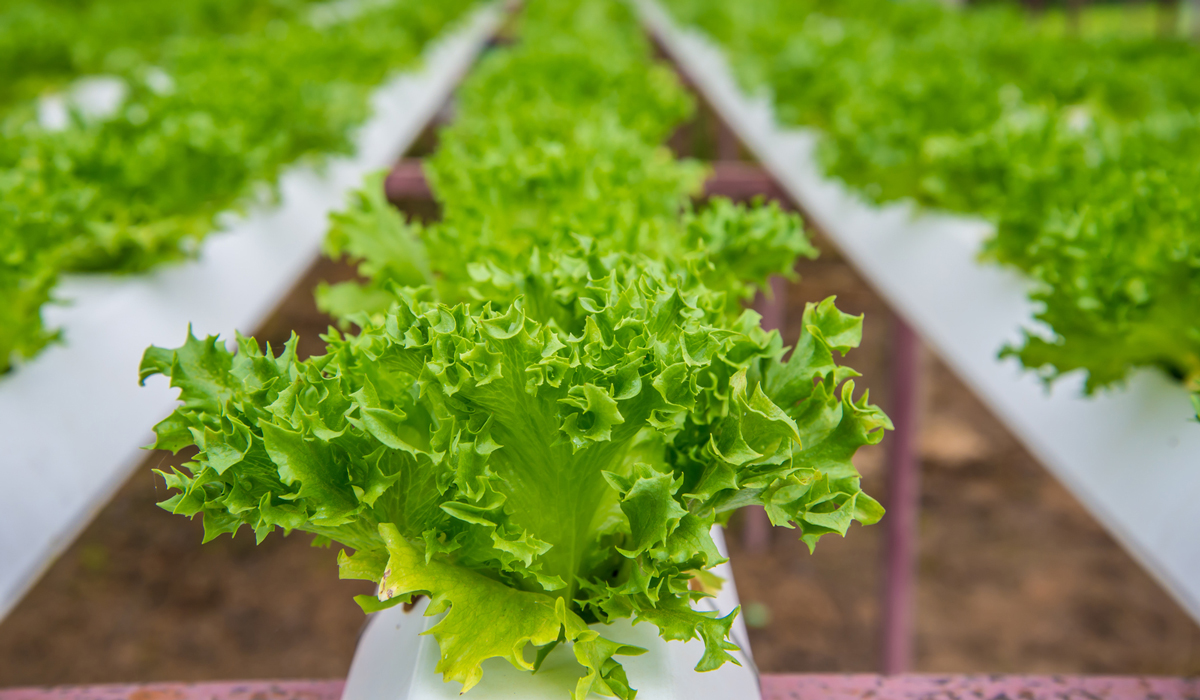Hydroponic Lettuce (A Complete Growing Guide)

This post follows our research editorial guidelines.

I love living in the great white north, that being said one of the biggest downfalls is our Canadian winters. Full of frosty mornings and frigid nights.
Not the best conditions for growing greens outdoors unless you have a heated greenhouse. Personally, I’d rather not take a break from growing greens along with nature and instead fire up my hydroponic system so that I’ll be harvesting veggies well into winter.

Lettuce is one of the best plants to grow in a hydroponic system because of how lightweight it is. Though they can take a few months to grow (depending on the type of lettuce you choose), they offer so much in one batch that you’ll have a continuous supply of these leafy greens to go with every meal.
Table of Contents
If you landed on this page, you want to know how to grow lettuce in an AeroGarden. While I answer this question in depth below, all you need to know is that lettuce thrives in all types of hydroponic systems and can be grown via seeds.
Growing my own lettuce hydroponically has been a game-changer for me, both in terms of quantity and the amount of money I save on my grocery bill. Here’s the complete guide to growing this healthy food in your very own hydroponic system:
Does Lettuce Grow Well in Hydroponics?
Yes, lettuce grows well in hydroponics. Not only does it grow well in hydroponics, but it’s also one of the most commonly grown hydroponic vegetables.
Lettuce especially thrives in the Deep Water Culture, Nutrient Film Technique (NFT) hydroponic systems and floating raft techniques. However, lettuce can grow in just about any kind of hydroponic technique you wish to use.

Starting Lettuce Seeds Hydroponically
Growing your own lettuce using hydroponics is easy to do. You can grow them from seeds and see them through to full growth with special care and attention given to them.
Here’s what you need to know to get started:
1. Setup Your Plug Trays
First, you have to set up your plug trays to ensure your plants will grow properly. You should use a moistened, soilless medium. This not only allows your seeds to start growing but acclimates them to growing without soil immediately instead of growing them in soil, only to remove them later down the line.
2. Plant Your Seeds
Add 2 or 3 seeds to each of the plugs. Make sure you cover your seeds with about ¼ inch of growing medium and press down to ensure that your seeds make contact with the medium.
Make sure you keep the medium moist through the germination process and keep the temperature between 60 and 68 degrees.
3. Use Lights to Grow Them
It’s best to Keep the seedlings in a sunny spot under LED lights once they start to grow. You need to provide about 14 hours of artificial light per day with the lights being only about 2 inches away from the plants.
Once your seedlings are 2 inches tall, thin out each plug to the strongest plant.
4. Transfer Your Seedlings to Your Hydroponic System
Once you have your seedlings thinned down to the strongest in each plug, you can now transfer them over to your hydroponic system. They’ll be ready for transfer sometime between 2 to 3 weeks after the initial planting of your seeds in the soilless medium.
Gently transfer each plant into each net pot, making sure that the roots dangle in the solution so they can soak up the nutrients they need to grow.
6 Best Types of Lettuce to Grow Hydroponically
Many lettuce types are great for growing in a hydroponic system. Here are 6 of the best that you can grow:
Grand Rapids
Grand Rapids lettuce takes anywhere between 45 to 60 days to grow. This kind offers a mild-flavored but juicy leaf that makes it ideal for use in a salad.
Another great reason to grow this type of lettuce hydroponically is that it thrives in low-light conditions which means that it will grow just fine under LED lights or fluorescent lights with less power.
Parris Island Cos
This is an excellent Romaine lettuce that has a mild flavor and takes longer to turn bitter when compared to other types of Romaine lettuce.
This lettuce takes between 55 and 75 days to grow and is a great way to try your hand at growing Romaine lettuce in a hydroponics system.
Buttercrunch
While its growing process is longer than others on this list (it takes between 60 and 70 days to grow,) it’s worth it. It has crisp leaves that have a buttery soft texture that makes it great for several different dishes.
We think it’s best in salads and wraps as well as on sandwiches and burgers. It’s a very flavorful variety that is tolerant to growing under hotter conditions.
Muir Lettuce
Muir is an excellent choice of loose-leaf lettuce. It shares qualities with the previously mentioned Grand Rapids while also having the added benefit of being disease resistant to both Lettuce Mosaic Virus and Downy Mildew while also having some of the best heat tolerance of any variety of lettuce.
It also takes about 50 days to grow, making it a great choice of lettuce variety to grow.
Salad Bowl
Salad Bowl lettuce is a tender yet sweet variety of lettuce that grows fast and plentiful. If you grow it normally, it can grow in full in about 50 days, but it’s possible in a hydroponic system to get full growth in less than 40 days.
It grows so quickly that it’s recommended to stagger your plantings every two weeks. Salad bowl lettuce also comes in both green and red varieties.
Little Gem Lettuce
The name isn’t just some quaint nickname. This small variety of lettuce is perfect if you’re looking to grow lettuce but you’re tight on space. It’s also good if you’re looking for a cute, fun little lettuce to grow.
Its tiny stature packs in big flavor. When it’s ready, harvest the whole head, cut it in half, and serve it with your choice of salad dressing for a great appetizer or healthy snack.
Light Needed For Growing Hydroponic Lettuce

Generally speaking, hydroponic lettuce needs about 10 hours of light per day. However, that can vary on the type of lettuce you’re growing hydroponically.
Muir lettuce, for example, needs between 14-16 hours of sunlight each day, whereas Buttercrunch lettuce needs between 10-14. Furthermore, the amount of light it needs will vary based on the stage of development.
Lettuce seedlings, for example, need up to 18 hours of light per day, and at least six hours of darkness during the night. Why? Because it helps mimic traditional outdoor growing methods.
Depending on the circumstances, you may also need to utilize supplemental lighting to achieve optimal growth.
Just be mindful of how you use supplemental lighting because according to Germán V. Sandoya, et al (an Assistant Professor from the Horticultural Sciences Department at UF/IFAS Everglades Research and Education Center, “too much lighting time can stunt plant growth and cause leaf distortion.”
Water / (Best pH for hydroponic Lettuce)
If you’re looking to grow your lettuce hydroponically, it’s recommended that you keep your pH levels between 5.6 and 6.2. Seedlings should be adjusted to 6.4 and then brought down to 6.0 as the plant matures.
This range makes the water acidic enough to reduce algae and its effects on your plant. If you go too high about this pH range, it falls into the alkaline range which will mean that your plant won’t be able to absorb the nutrients it needs to grow.
Best Growing Medium For Hydroponic Lettuce
Deep water culture is best for growing lettuce hydroponically. Though lettuce can thrive in any hydroponic system, a deep water culture (DWC) offers the best results. It encourages healthy plant growth because it’s easier for the roots to absorb nutrients.
If you plan on using this method, you should also purchase clay pebbles to add to your hydroponic system. Clay pebbles help circulate air to aid in healthy root development.
While you can use this method for commercial purposes, as well, a nutrient film technique (NFT) is usually better for industrial use.
Nutrients Lettuce Needs
When it comes to nutrients, you must keep a proper NPK Ratio for growing lettuce. The NPK Ratio is the amount of nitrogen, phosphorus, and potassium a plant needs to grow.
Lettuce requires a fairly balanced ratio where the three numbers that represent those three nutrients are either exactly the same, or close enough. Besides the NPK Ratio, it’s important that your lettuce also gets copper, manganese, iron, and boron.
These micronutrients prove more for your plant to grow and thrive.
Pruning Lettuce Leaves

When pruning your lettuce, you must focus on removing older and damaged leaves from the plant. This helps it stay healthy and keep growing. Another great reason to prune your lettuce is to use the “cut and come again” method of harvesting.
This means you can cut larger leaves off of an existing lettuce plant and allow the smaller leaves to keep growing.
Spacing Hydroponic Lettuce
Spacing is an important factor in hydroponic plant growth because overcrowding is possible depending on how large your plants are or how much you have currently grown.
In most cases, you should aim to keep your lettuce plants about 6-8” apart from one another. This prevents overcrowding, which will help ensure a healthy crop.
However, there’s another reason why spacing in hydroponics is so important – especially when it comes to growing lettuce. Some studies have shown that lettuce grown hydroponically is more prone to bacterial infestations as a result of the wet and often humid environment.
If plants aren’t separated enough, this infestation becomes worse and could lead to actual diseases such as mildew.
Pests That Love Lettuce
Like all other crops grown hydroponically, lettuce is still at risk of developing pests.
Whiteflies, mites, aphids, and thrips are the most common pests to affect hydroponic lettuce plants, mainly because all of them can survive in an enclosed environment.
This is why, if you’re planning on growing lettuce hydroponically, you hang up some sticky traps around your plants to catch any pesky intruders such as these.
Diseases To Be On the Look Out For
Hydroponic lettuce is susceptible to a couple of different diseases if you’re not careful with taking care of your plants. The most dangerous of these are water molds such as Phytophthora and Pythium.
These are waterborne molds that can quickly infect all of the plants in your system if they are not detected early enough. Unfortunately, there’s no way to prevent this from happening.
If it does occur, you need to disinfect all of your equipment before starting the growing process over. Hydroponic lettuce is also susceptible to bacterial infections including different types of mildew.

FAQ
How Long Does Hydroponic Lettuce Live?
If harvested lightly, hydroponic lettuce can stay alive for many months. Keep the lettuce cool to avoid bolting at the 3-4 month mark when your hydroponic lettuce will want to flower.
Is Hydroponic Lettuce Healthy?
Generally speaking, yes, hydroponic lettuce is healthy. However, whether it’s healthier than lettuce grown in soil depends on the type of nutrients added to the batch.
Though hydroponics removes the need for soil, plants grown with this method still need to have nutrients to survive. These store-bought nutrients, however, may contain chemically-altered nutrients, causing the lettuce to not really be as organic as people may claim.
As with any product, do your research to find out what you’re comfortable with. A lot of research is still coming out on this subject.
Do You Need to Wash Hydroponic Lettuce?
Yes, the only reason why lettuce and other crops are washed after harvesting is that they’re plucked from the soil, which often contains pesticides. However, that doesn’t mean you shouldn’t wash your hydroponic lettuce.
Washing your hydroponic lettuce off before consuming it removes pests that may be hard to see, as well as any dirt, dust, or pathogens that may be on it. These things are common regardless of whether you’re using a traditional soil method or a hydroponics system.
Final Thoughts
Growing lettuce hydroponically is an easy way to have a constant fresh supply of lettuce. And since there are so many types of lettuce that grow well with this method, there’s no shortage of what you can grow.
As long as you know what you need and how to combat pests and algae, you’ll have the perfect batch of hydroponic lettuce every time.

Before you go!
9 Alternatives for Peat Moss
Hydroponic Deep Water Culture? Get Growing in 10 Easy Steps
Using Perlite in Hydroponics: A Complete Growing Guide
Hydroponic Mint (Key Things Beginners Need to Know)